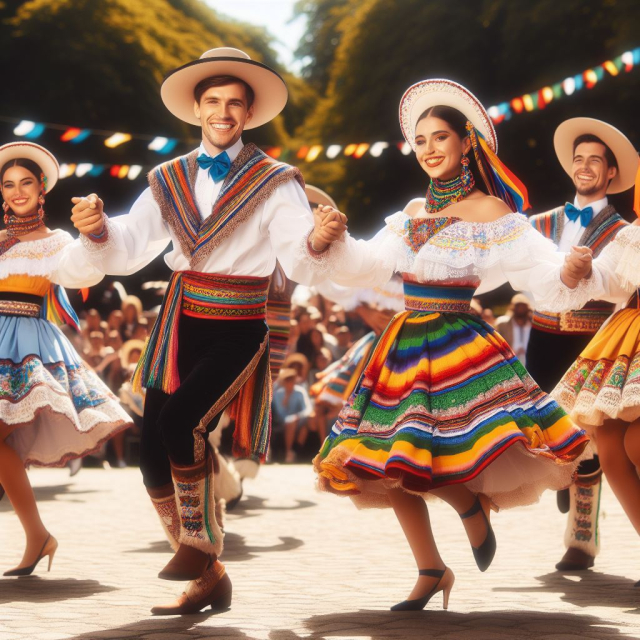Since time immemorial, dance has been a cultural expression that reflects the identity, traditions and history of a people. In Ecuador, a country marked by its rich ethnic and geographic diversity, dances play a crucial role in the manifestation of the vibrant cultural heritage that spans the Andean highlands, the Amazon rainforests, and the Pacific coasts. Join us and explore some of the most characteristic dances of Ecuador, immersing ourselves in the passionate rhythm that defines the artistic expression of this South American country.
The bomb.
The Bomba is one of the most emblematic dances of the coastal region of Ecuador, especially in the province of Esmeraldas. Originally from the Chota Valley and the Afro-Ecuadorian population; La Bomba is a fusion of African, indigenous and Spanish rhythms. Accompanied by drums and maracas, this narrative dance is characterized by vocal improvisation and sensual movements that reflect the history and resistance of the Afro-Ecuadorian community.
The Sanjuanito.
Coming from the Andean region, the Sanjuanito is a traditional dance that celebrates the fertility of the land and the festivities of San Juan. The dancers, dressed in colorful and ornate costumes, perform energetic moves and acrobatics to the beat of upbeat music. This festive dance reflects the deep connection between the land and the community, and is an essential component in events such as Inti Raymi celebrations.
The Diablada.
The Diablada is a folk dance that has roots in the Andean region and is especially prominent in the city of Ambato. The dance represents the fight between good and evil, with dancers dressed as devils and angels. The colorful costumes and elaborate masks contribute to the spectacular nature of the Diablada, which is performed at festivals and religious celebrations, such as the Fruit and Flower Festival.
The hall.
El Pasillo is a musical genre and a dance that originated in the Ecuadorian Sierra, however its greatest exponents have come from the city of Guayaquil. Although its name suggests a slow dance, the Corridor can vary in speed and style. The dance is often accompanied by melancholic lyrics and is danced in pairs, reflecting the influence of European romantic music on Ecuadorian culture.
Capoeira.
Although Capoeira has roots in Brazil, this form of physical and artistic expression has also been integrated into Afro-Ecuadorian culture. Capoeira combines elements of dance, acrobatics and music, and is practiced in circles where participants face each other in an athletic game. This unique form of body expression has gained popularity and has found its place in Ecuador's cultural scene.
The Dance of the Scissors.
Although it is native to Peru, it is very popular in the Ecuadorian Andean region. The Scissors Dance is a cultural manifestation that combines elements of dance, music and acrobatic skills. Dancers perform complex, challenging moves to the beat of music, all while holding sharp scissors. This dance has roots in indigenous traditions and is a testament to the physical prowess and spirituality of Andean communities.
The Yumbo.
Yumbo is a pre-Columbian dance originating from the Santo Domingo de los Tsáchilas region. Performed by the Tsáchilas, an indigenous community, Yumbo is a ceremonial dance that celebrates the connection between the earth and the cosmos. The dancers, dressed in feathers and masks, perform rhythmic movements that symbolize fertility and harmony with nature.
The Cachullapi.
Coming from the Imbabura region, the Cachullapi is a happy and festive dance that is performed during celebrations and popular festivals. The dancers, dressed in traditional costumes and masks, perform energetic movements and acrobatics while carrying musical instruments. The dance reflects the joy and vitality of the Imbabureño culture.
The Crier.
The Pregonero is a dance that honors street vendors and their traditional sales calls. Originating from the Andean region, this dance incorporates comedic and theatrical elements as dancers represent street vendors and their interactions with customers. The Crier is a fun and unique expression of everyday life.
The Dance of the Shacshas.
Very popular in the Ayacucho region, the Dance of the Shacshas is a colorful and symbolic representation of the harvest. The dancers, dressed in elaborate costumes and wearing wooden masks, perform movements that symbolize planting, plant growth, and harvesting. This dance is a celebration of the connection between the community and the land.
Preserving Tradition Through Dance.
As society advances and changes, the preservation of cultural traditions becomes essential. In Ecuador, dances play a crucial role in transmitting cultural identity from generation to generation. Through dance, stories are told, victories are celebrated, and the eternal connection between the community and its environment is honored.
Whether in the highlands, on the coast or in the jungle, the dances of Ecuador bear witness to the diversity of the country and its people. Every movement, every rhythm, tells a story that resonates with the soul of the nation. Dance in Ecuador is not simply an artistic expression; It is a link to the past, a reflection of the present and a seed for the future. At every turn and every step, Ecuador's passion remains alive, marking the beat of a story that continues to be written in every celebration and festival.
